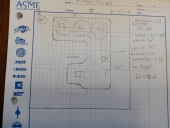I have built two
L-tube rocket fired evaporators, 8 and 6 square feet. An 8" wide x 9" high burn tunnel about 32" long, with a riser around 30" high, was barely enough for 2' x 4', but okay for a 30" square pan. With proper wood selection (as many larger logs up to 5" diameter as possible), the logs hold their shape until nearly burned and do not collapse in a choking pile of coals. I have run a 10+ hour session without raking out coals. Your fuel source may make this difficult.
This is to say that a single larger L-tube will probably be steadier and easier to maintain than a pair of smaller rockets.
I cut wood to 30 or 32" lengths - less cutting and handling, and pushes all the way to the back of the firebox at one go.










